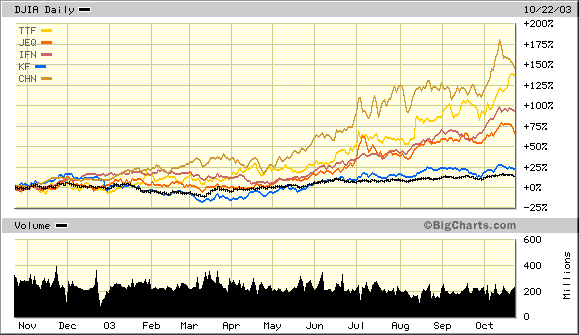

Are We Entering a dot.Asia Environment?
By Keith W. Rabin
In many ways the rapid appreciation of
Asian equities in recent months is reminiscent of the heady bull market
run-ups seen in the dot.com market a few years ago. Responding to a client
request, KWR International recently reviewed the performance of Asia-related
closed-end mutual funds and found even most of the laggards had appreciated
25% or more over the past year.

To cite one indicator, Emergingportfolio.com recently
reported “The
rush of liquidity into the [Asia/Pacific] region … have nearly
doubled the assets in the 285 Asia ex-Japan equity funds that EPFR tracks
weekly to $21.2 billion from $11.8 billion at the beginning of 2003.
By October 15 these funds had received total inflows year to date of
$2.7 billion. This is more than three times the $782 million worth of
net investor contributions in all of 2002.”
The key question therefore is whether this is simply speculative froth
or a reflection of a fundamental paradigm shift that will unfold over
time. The answer is not so simple.
In a recent article in our KWR International Advisor newsletter, Marc
Faber contrasts official estimates that the US has a GDP of about $11
trillion against $2.2 trillion for Emerging Asia (including China and
India, but excluding Hong Kong, Japan, Singapore, South Korea, and Taiwan
- which are classified as advanced economies) and concludes when measured
on a purchasing power parity basis the U.S. is nowhere near five times
as large as Asia.
Faber backs his analysis with numerous figures highlighting the size,
importance and growth of Asia and its impact on commodities and other
markets, noting “ … if we compare the true size of Asia with
the extremely low weighting some Asian countries have within the MSCI
World Free Index, it becomes obvious that some big changes are likely
to take place in future. …. Is Asia ex-Japan really worth around
5% of the world’s entire market capitalization … and is the
US worth 11 times the Asian market capitalization ex-Japan?” We
concur with these thoughts and would add Japan back into the data, taking
Asia’s weighting within the MSCI World Free Index up to 12.1%.
This seems small given the impact of this region on the global economy.
On the other hand there is a mania of sorts emerging in respect to Asia
and one anecdote is the recent performance of ICICI, a major Indian financial
institution. ICICI, which trades as an ADR in New York as IBN is a fine
bank and a long-time personal favorite. It is ideally positioned to appreciate
alongside the rise of India’s emerging middle class and their desire
for mortgages and other retail financial products.
In early October, however, a domestically-oriented stock jock touted
this security on Fox News' "Bulls & Bears" morning show.
The stock, which had been appreciating on a fairly steady basis over
the previous year -- suddenly took off like a rocket. Closing on October
3rd at $11.21, on the following Monday it opened at $14.59, rising slightly
before closing at $12.23. Almost three million shares traded – ten
times the average daily volume. It has since held steady though recently
fell to the high 11’s, still comfortable above where it was before
this mention.
The key point here is this is not a speculative start-up but a major
financial institution with a long history and 11,000 employees. Nevertheless,
this one mention on a national television show resulted in a temporary
appreciation of over a billion dollars in market capitalization. One
can also look at the yearly performance of China-oriented dot.coms and
many other Asia-related securities and see similar -- and in some cases
even more dramatic -- upside momentum.
What does this mean for investors? Rising trade and fiscal deficits,
excessive stimulation, higher military costs and a depreciating dollar
are just a few of many reasons that Asian markets are likely to perform
better than those in the United States in the foreseeable future. While
there will likely be upsets and concerns -- including most importantly
the potential impact of downward movements in the U.S. on export-dependent
Asia -- we believe the fundamental trend favors the stronger growth and
emerging consumer base that is developing in Asia Pacific markets.
That said, we would urge U.S.-based investors and fund managers who are
underexposed to Asian markets to gain a more nuanced appreciation of
the dynamics driving the region in order that they might raise their
allocations in an effective manner. Those that are fully- or over-weighted
also need to keep a close watch to monitor their investments and to make
additional purchases on a selective basis.
